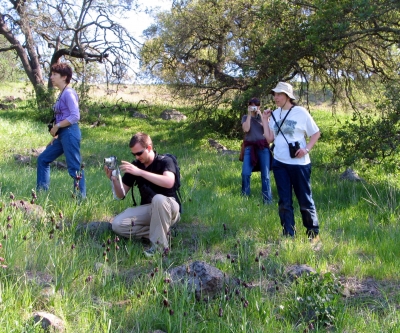A villain of the blackest dye!
Research news
Prominent American behavioural ecologist Professor Marlene Zuk provided a fascinating look into the rapidly changing lives of male Hawaiian crickets on her recent visit to Deakin University’s Centre for Integrative Ecology.
The dulcet tones of cricket song that we find so relaxing on warm evenings are actually the advertisement calls of sexually receptive males.
However, as Professor Marlene Zuk who is visiting Australia from the University of California told a gathering at Deakin University’s Centre for Integrative Ecology, a nasty threat has loomed over Teleogryllus oceanicus populations in Hawaii.
“A villain of the blackest dye, the parasitoid fly Ormia ochracea, emerges at night to prey on hapless male crickets,” Professor Zuk explains.
“Female flies home in on male cricket song, and squirt live larvae on to their hosts.”
The larvae then burrow through the cuticle and feast on various internal cricket structures. After a week or so, the engorged, pulsing maggots burst out of their host leaving a hollow cricket husk behind.
“Clearly, this is not a desirable situation to be in if you are a male cricket,” Professor Zuk said.
“Our research team then made an astonishing discovery on the Hawaiian island of Kauai.
“In 2003, an eerie silence had descended on the population. Had all the males ceased calling? Had the population gone extinct?
“After some investigation, we discovered that a dramatic morphological mutation had arisen in some males, causing the loss of sound-producing structures on their wings. These flatwing males are protected from predation by acoustically orienting parasitoids.”
The proportion of flatwing males on Kauai has increased from zero to nearly 90 percent in fewer than 30 generations, representing one of the fastest evolutionary shifts documented in a wild population.
Of course the silence did nothing for the sex lives of the male crickets.
The muted males could no longer perform the songs thought to be essential for attracting female crickets and ensuring reproduction.
“What is a male to do,” Professor Zuk asked?
It seems they got cunning, very cunning. They hang out with males who could still chirp to attract females and then intercepted the female.
The mutation seems to have been accompanied by looser standards on the part of the female crickets.
In other cricket populations, silent males are rejected.
By being less choosy – for reasons Professor Zuk is still exploring by raising both males and males with and without song - the females had played their part in creating this rapid evolutionary shift.
“I doubt this rapid shift could have happened if we didn’t have this behavioural plasticity,” Professor Zuk said.
As well as Hawaii’s islands, Professor Zuk has also looked at populations in Carnarvon and Mission Beach in Australia.
She wonders if those populations might still exist following the recent cyclones.
“It makes me wonder if catastrophic events also have played a part in Hawaii which is subject to volcanic eruptions.
“There is still so much more to try and understand about what has been happening with the cricket populations in Hawaii.
“Essentially, crickets live to sing, it is what they are born to do, but for them to fall silent is incredibly interesting in what is an already fascinating example of natural versus sexual selection.
Share this story
 Professor Marlene Zuk (far left) in the field.
Professor Marlene Zuk (far left) in the field.
